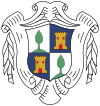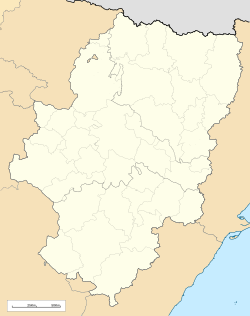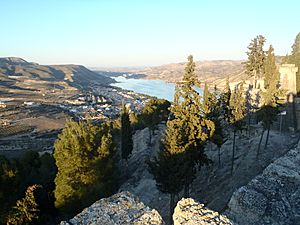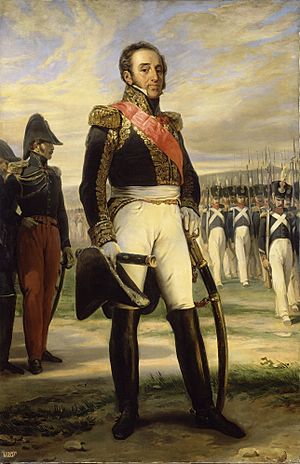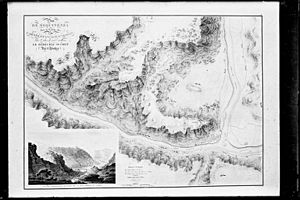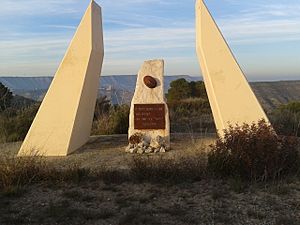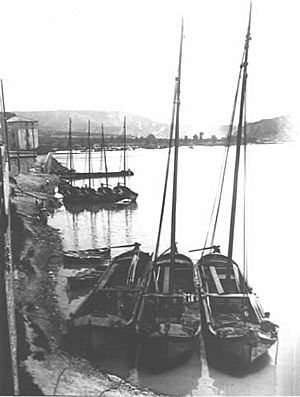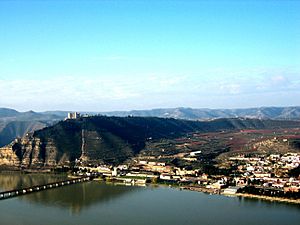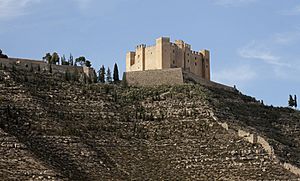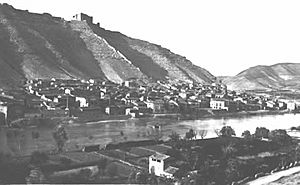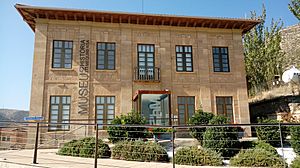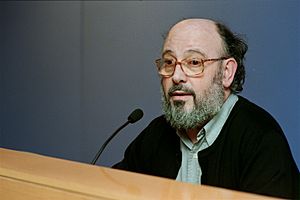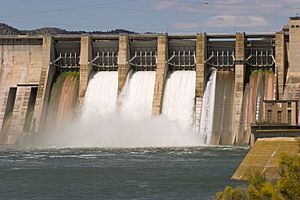Mequinenza facts for kids
Quick facts for kids
Mequinenza
Mequinenza
Mequinensa |
|||
|---|---|---|---|
|
|||
| Country | Spain | ||
| Community | |||
| Province | Zaragoza | ||
| Comarca | Bajo Cinca/Baix Cinca | ||
| Area | |||
| • Total | 307.2 km2 (118.6 sq mi) | ||
| Elevation | 75 m (246 ft) | ||
| Population
(2018)
|
|||
| • Total | 2,301 | ||
| • Density | 7.4902/km2 (19.400/sq mi) | ||
| Time zone | UTC+1 (CET) | ||
| • Summer (DST) | UTC+2 (CEST) | ||
Mequinenza, also known as Mequinensa, is a town and municipality in the Province of Zaragoza, Spain. It's part of the Aragon region. The town is located right next to the river Segre, close to where it meets the mighty Ebro river. It sits between two big dams: the Mequinenza Dam and the Riba-roja reservoir.
Mequinenza is famous for its large reservoir, often called the "Sea of Aragon." This huge lake was built between 1957 and 1964. It can hold a massive amount of water, making it one of the biggest reservoirs in Spain. It's also a top spot for rowing and canoeing. Many people think its regatta field is one of the best in Europe. This is because it's easy to get to and the water level stays very steady. Every February, the town celebrates the San Blas and Santa Águeda Festivities. These events are so special that they are considered a Festival of Tourist Interest in Aragon.
Contents
What's in a Name?
The name Mequinenza comes from the word "Miknasa." This was the name of a Berber tribe that built a fort here in the 8th century. Over time, the name changed a bit. You might see it written as Miquinencia, Mquinensa, or Mequinensa. Today, in Spanish, it's Mequinenza, and in Catalan, it's Mequinensa. Locals sometimes call it "lo poble," which means "the town."
Mequinenza's Past and Present
Mequinenza is built where an ancient city called Octogesa once stood. This old city was important during a big battle in 49 BC. This battle was fought between the armies of Julius Caesar and Pompey Magnus. Since 1983, archaeologists have been digging in the area. They have found three main sites: Los Castellets, Barranco de la Mina Vallfera, and Riols I.
- Los Castellets: This site helps us understand how people lived from the Late Bronze Age to the Urnfield culture. It was a settlement on a river bend, protected by towers, a wall, and a ditch.
- Barranco de la Mina Vallfera: Here, archaeologists found an important group of necropolis (ancient burial grounds). These date back to the end of the Neolithic period.
- Riols I: This site is similar to Barranco de la Mina Vallfera. It also dates from the late Neolithic period.
Many ancient paintings and engravings have been found in Mequinenza. These belong to the Rock art of the Iberian Mediterranean Basin. This art is so important that UNESCO made it a World Heritage Site in 1998.
Ancient Times and the Middle Ages
In Roman times, the old city of Octogesa was near where Mequinenza is today. When the Roman Empire began to decline, the Goths took over Octogesa. Later, the Berber tribe called Miknasa conquered it. They gave the town its name. It was known as Miknasa al-Zaytun, meaning Miknasa of the Olives. This name was also given to a city in Morocco. It's believed that Miknasa al-Zaytun was settled around 714 to 719 AD. During this time, a small defense tower was built.
During the Reconquista (when Christians took back land from the Muslims), Alfonso the Battler tried to capture Mequinenza in 1133. He succeeded, but the Almoravids took it back the next year. Finally, Christian armies won Mequinenza for good on October 24, 1149. After some time under royal rule, Mequinenza became part of the Moncada family's lands. They built the important Mequinenza Castle. Even after the Christian conquest, many people in the area were still Muslim.
The plague hit Mequinenza in 1348, causing many deaths. More outbreaks happened in the 1380s. In 1410, during a time of political trouble, supporters of Jaime de Urgel held their parliament in Mequinenza. This was against the parliament in Alcañiz, which supported Fernando de Trastámara.
Modern History
The 15th and 16th centuries were tough times with poverty and hunger. In 1697, a book about Santa Agathoclia, Mequinenza's patron saint, was written. In the early 1700s, during the War of succession, silkworm farming was important. Wars like the Catalan Civil War (1462–1472) also damaged the town and its castle.
In 1810, during the Napoleonic invasion, General Louis-Gabriel Suchet conquered Mequinenza. This helped the French take over more areas. Because of this victory, "Mequinenza" is even written on the Arc de Triomphe in Paris. In 1812, Mequinenza became part of a French department. But in 1814, Juan Van Halen helped Spain get Mequinenza back. By 1831, the town and castle belonged to the Dukes of Medinaceli.
The castle of Mequinenza was updated for new types of warfare. A road connecting Mequinenza to Tortosa was also improved. In the 18th century, José Ferrer Beltrán, a famous musician, was born in Mequinenza. The old city of Octogesa also interested many travelers.
In the early 1800s, farming was still the main way people made a living. In 1802, King Charles IV allowed a new church to be built. It was designed in a Neo-Renaissance style.
The Siege of Mequinenza
During the Peninsular War (part of the Napoleonic Wars), the siege of Mequinenza began on May 15, 1810. Mequinenza was a key spot for the French army. It helped them control the Ebro river and use the town for supplies. The French tried to take the town peacefully first, but the Spanish defenders refused.
Then, General Louis-Gabriel Suchet ordered an attack. The siege started on May 19. Around 16,000 French soldiers attacked the town. The Spanish defense had about 1,200 men. On June 2, the French began digging trenches and setting up cannons. The Spanish soldiers left the town on June 3 and went into the castle. The French took the town on June 4.
With the town taken, General Suchet focused on the castle. On June 7, the French started firing 16 cannons at the castle. The Spanish fought back hard, but the castle walls began to break. On June 8, the Spanish soldiers, after a strong fight, finally surrendered. They were allowed to parade in front of the French general. The French found many supplies inside the castle.
Mequinenza was then controlled by the French. But in 1814, Juan Van Halen helped Spain get it back. The name "Mequinenza" is still on the Arc de Triomphe in Paris.
In 1824, a British artist named Edward Hawke Locker described Mequinenza. He noted its location at the meeting of the Segre, Ebro, and Cinca rivers. He also said it was a fortified town with about 1,500 people.
Mequinenza was important again during the Carlist Wars. In 1841, a businessman tried to start a steamship service on the Ebro. He wanted to use coal from Mequinenza's mines as fuel. His plan didn't work out, but it started the coal mining industry in the area.
Spanish Civil War
During the Spanish Civil War (1936–1939), Mequinenza was a site of fierce fighting. This happened during the Battle of the Ebro in 1938. The Auts area saw very violent battles. On July 25, the Republican army tried to cross the Ebro river here. Their goal was to secure a bridgehead and cut the road to Maella.
The fighting at the Auts was one of the bloodiest of the entire battle. Many soldiers from both sides were killed or injured. The Republicans kept attacking, but the Francoist forces brought in more soldiers. On August 1, the Francoists counterattacked. The Republicans tried again to advance, but on August 6, the Francoist army launched a final counterattack. This forced the Republican soldiers to retreat back across the Ebro. The bridge over the Ebro in Mequinenza was destroyed during this battle.
Sixty years later, on August 8, 1998, a monument was built at Alto de los Auts. This monument honors the Republican survivors of the "Quinta del Biberón" (a group of young soldiers). The monument has two plaques, in Catalan and Spanish, and two helmets. It says: 'To all those who lost, who were all'. Many veterans and their families came to the ceremony. They remembered the hard conditions they faced during the fighting.
20th Century Changes
Coal Mining in Mequinenza
The 20th century brought a big demand for coal. This led to the growth of the Mequinenza coal basin. At first, coal was dug from underground tunnels. Wagons were pulled by animals until around 1920, when machines and electricity took over.
In 1880, the Carbonífera del Ebro company was started. It became the most important mining company in the area. Mequinenza grew a lot because of the mines. From 1900 to 1920, the town's population grew from 2,400 to 4,200 people, mostly men. This happened again in the 1940s. Many miners came from other parts of Spain. Mining changed Mequinenza from a farming town to a mining town.
The Towpath
Llauts were traditional wooden boats, about 20 to 25 meters long. They were very important for carrying up to 30 tons of lignite (a type of coal) on each trip. These boats used the river's current to go south. To return to Mequinenza, they used square sails if the wind was blowing. If there wasn't enough wind, the Llauts had to be pulled from the shore upstream. This was called "Camí de Sirga" (or towpath in English). Until 1914, three men pulled each Llaut.
A company tried to use steamships, but the Ebro river was too difficult. In 1920, another company decided to use animals instead of people to pull the boats. This was a unique transport system. Coal from the mines was taken to landings by the river. From there, it traveled by river to places like Tortosa or Fayón.
The End of Coal
In 2010, one of the main coal mining companies in Mequinenza, MIBSA, closed down. In 2013, Carbonífera del Ebro faced big problems. The company that bought their coal refused to do so. This put many jobs in Mequinenza at risk. The miners protested, even marching to Madrid. They were proud that their coal had powered factories for over 130 years. In 2014, Carbonífera del Ebro announced it was closing its doors.
From Old Town to New Mequinenza
The building of the Ribarroja and Mequinenza dams changed Mequinenza forever. Most of the old town was flooded by the rising waters. Even though the water didn't cover everything, it ruined most of the farmland by the river. The town's economy, based on mining and river trade, disappeared. The only building saved from the old town was the María Quintana School Group. Today, this building is home to the Museums of Mequinenza.
Mequinenza was reborn when its people built a new town. It's just a few kilometers from the old site. The new Mequinenza is modern and focuses on tourism. It offers active sports and cultural activities in the Bajo Cinca/Baix Cinca region.
Places to Visit
Mequinenza Castle
The Mequinenza Castle stands high on a cliff, looking over a huge and amazing landscape. It's located where the Ebro, Segre, and Cinca rivers meet. It's easy to see why the Moncada family, who owned Mequinenza, chose this spot for their fortified home. The castle is a true Castle-Palace, one of the best examples of Gothic art in the Crown of Aragon. It was built in the 14th and 15th centuries.
It started as an Arab fortress, built by the Miknasa tribe around the 12th century. After many battles, it fell into Christian hands. In 1184, the castle and town were given to the Marquis of Aitona, and later to the Dukes of Medinaceli. But it wasn't until the 15th century that it was changed from a military fort into a palace.
Later, during the War of Succession (1700–1710), the castle was updated for new weapons like cannons. The Duke of Orleans ordered a road to be built along the river. This road connected Mequinenza to Tortosa and helped guard the river boats.
During the War of Independence (1808–1814), the castle was attacked three times by Napoleon's army. In 1810, General Suchet's troops captured it. Mequinenza was under French rule until 1814. But in February of that year, it returned to Spanish hands without a fight, thanks to a clever plan by Van Halen. The castle was used as a military base until the early 20th century. During the Civil War, it was a Republican observation post and prison. After the war, it was in ruins until the ENHER company rebuilt it in the 1950s.
Today, the castle belongs to the ENDESA Foundation. If you want to visit, you need to ask the Mequinenza Tourism Office in advance. Guided tours are usually on Tuesday mornings.
Old Town of Mequinenza
The old town of Mequinenza was on the left bank of the Ebro river. It often faced floods from the river. But the Ebro also brought trade to Mequinenza. The town became known for its boat builders and "struts" (people who pulled the boats). At its busiest, Mequinenza had a fleet of 16 llaüts, boats that could carry 18 to 30 tons of goods. For a long time, coal mining was the main way people made a living.
When the ENHER company arrived to build the dams, life changed a lot. Many workers came to Mequinenza. The mines started to close because the water level from the Ribarroja dam rose. This caused many people to leave Mequinenza. Some went to work in mines in other countries, others moved to different parts of Spain. But most stayed and built the new Mequinenza.
By the end of 1974, most people had moved into their new homes. Mequinenza was probably the first town in Spain where everyone owned their own house.
Museums of Mequinenza
At the Museums of Mequinenza, you can explore a real underground coal mine. It's over 1000 meters long! You can see how coal was dug out for more than 150 years. In the Museum of History, you can learn about the town's past. You'll discover what happened when the old Mequinenza was flooded by the Ebro river. The Museum of the Prehistoric Past shows you how people lived long, long ago. The museums opened in 2006 and are located in the old María Quintana School Group building.
The museums focus on Mequinenza's history, culture, and industry. They tell the story of the town that disappeared under the Ebro's waters. You can still visit parts of the old town and the medieval castle. The "Camí de Sirga" lodge is also next to the museums. It's named after the old path used by boats to go up the Ebro river, carrying coal.
Jesús Moncada
Jesús Moncada i Estruga was a writer and translator born in Mequinenza in 1941. His stories are a mix of real life and fantasy. They bring to life the amazing past of the old town of Mequinenza, which is now underwater. He is one of the most important Catalan writers of his time. He won many awards for his work. These include the Premio Ciutat de Barcelona and the Premio Nacional de la Crítica in 1989 for his book Camí de sirga (The Towpath). He also received the Creu de Sant Jordi in 2001. In 2004, shortly before he passed away, he received the Premio de las Letras Aragonesas.
Moncada is one of the most famous and translated Catalan authors. His book Camí de sirga has been translated into fifteen languages, including Japanese and Vietnamese. He also translated many books from Spanish, French, and English into Catalan.
His novel Camí de Sirga (The Towpath) (1988) tells the story of a town at the meeting of the Ebro and Segre rivers. It's told through the memories of its people. These memories pile up until the 20th century. They are brought out by the building of a reservoir and the town's flooding. The book also makes you think about history, memory, and stories. It has a feeling of longing for the past, but it's also funny at times. It shows how people in a small town interact and how big events like the First World War and the Spanish Civil War affected Mequinenza.
Natural Wonders
The Sea of Aragon
The Mequinenza reservoir, also known as the "Sea of Aragon," is very popular with fishermen. Many people come from northern Europe to fish for the huge Wels catfish (Silurus glanis). These fish can grow to be over two meters long and weigh more than one hundred kilos! Besides catfish, you can also find carp and other fish. Fishing for black bass is also growing in popularity. Catfish were first put into the Mequinenza reservoir in 1974.
The reservoir was built in 1966 on the Ebro river. It covers 7,540 hectares of water, making it the biggest reservoir in Aragon. It holds 1.53 billion cubic meters of water. It's used to make electricity. The reservoir is about 600 meters wide on average and can be over 60 meters deep. The dam itself is 79 meters high.
The building of the Mequinenza Dam and the Ribarroja Dam led to the destruction of the old town of Mequinenza. The rising water flooded the town and its farms. The authorities decided to tear down the entire town, even the church. Many people lost their jobs, especially in the coal mines, because the mines were flooded. But the people of Mequinenza didn't give up. They built a new, modern town near the Segre river.
Fishing is a huge draw for visitors to the "Sea of Aragon." From the start, people knew the reservoir would attract tourists. Fishing clubs quickly started organizing activities. In 1965, many young largemouth bass and royal carp were released into the water. This was the beginning of the rich fish population today. It's thought that the reservoir has over 50 million fish! Many fishing guides work here, using boats to explore the vast waters.
Aiguabarreig: Where Rivers Meet
Near Mequinenza, the Segre, Cinca, and Ebro rivers meet. This special area is called the Aiguabarreig. It's a place with amazing natural beauty and many different types of environments. You can find everything from dry Mediterranean steppes to thick riverside forests. The rivers here are hundreds of meters wide, with many islands, forests, reed beds, and pebble beaches.
This area is unique because it's where plants from the dry Monegros region meet plants from the Ebro valley. This means you can find species that usually live in very different places. Birds are the most common animals here. You can see many types of birds, from water birds to birds of prey and desert birds. Reptiles, amphibians, and mammals also live here. You might spot bats, deer, otters, and even wild goats.
Around Mequinenza, there are places for people to stay and sports clubs. These clubs often organize water sports like sailing, canoeing, and motorboating. Mequinenza has become a famous place for water sports. Many rowing and canoeing teams, like those from Oxford and Cambridge, come here to train. This is because the rivers have a steady water level, making it one of the best regatta courses in Europe.
Local Government
Mayor: Magdalena Godía Ibarz, from the Spanish Socialist Workers' Party (PSOE)
See also
 In Spanish: Mequinenza para niños
In Spanish: Mequinenza para niños



